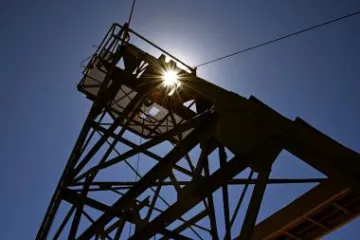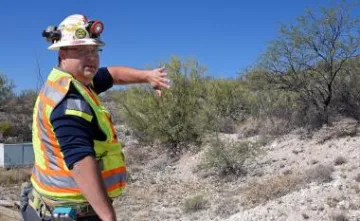The expansion of the University's underground mine

The San Xavier Mining Laboratory south of Tucson
Tucson, June 30, 2020 - scroll down for updates
A $173,000 investment by the University of Arizona will launch efforts to make its underground mining laboratory a premiere educational research facility in North America.
An expansion project that gets underway in summer 2020 will add research, teaching and training opportunities to the of the Department of Mining and Geologic Engineering's Henry G. “Hank” Grundstedt San Xavier Mining Laboratory. It includes installation of sophisticated sensor systems and the start of a decline to the lower levels of the 1880 mine.
“This is just crucial for the University of Arizona because there are not many underground mine labs around North America,” said Gail Heath, research professor with the Mining and Geological Engineering Department of the College of Engineering. “This really goes a long way to putting us no. 1 in that area.”
The laser-based sensors will monitor rock movement and mine airflow and temperature. A portal and about 70 feet of an eventual 1,000-foot-long, 15-foot-wide and 15-foot-tall decline will allow big, modern, rubber tired equipment to enter the mine located 23 miles south of Tucson.
A more modern lab for researchers
A decline is a sloping ramp that connects the levels of a mine with the surface. It allows for heavy equipment such as drills, dump trucks and loaders to get into the mine without depending on a rail for access. The portal, the surface opening of the decline, often provides space to park and store machines that will use the decline.
James Werner, assistant director of the mining laboratory, said getting the decline project started is particularly important to making the mine a world-class research and education facility. He hopes that this effort can spur interest in it as a real-world, modern lab. “It’s a place to start to say we have a portal and we’re 70 feet in,” Werner said.
Having the sensors and the decline will offer many opportunities to examine ways to improve mining operation efficiency and safety. “We can start leading the industry on research,” said Heath. The expanded San Xavier mine will provide facilities for use by government agencies, public and private consortiums and UArizona researchers and innovators across the university. “Those are the three areas I’ve been pushing for on getting this thing happening,” Heath said. “I think once we start having this decline in place and all the rest of the infrastructure, people will be lining up to work with us.”

The hoist at San Xavier mine
Real-world experience for students
Right now the underground mining laboratory doesn’t meet all the needs of teaching modern mining. It was a private mine that produced silver, lead, zinc and copper until 1952. The UArizona College of Mines operated one shaft in 1958 and has owned it since 1975. With three more adjacent mining claims, the UArizona has nearly 90 acres. It has a sophisticated mine hoist—like an elevator—and rail haulage access. It has a narrow decline and four levels of underground workings down to 250 feet. The site includes a training center with classrooms, offices, research space, lockers and showers.
The lab is structured as an operating mine that students work, including holding positions of mine manager, safety manager, shift foremen and hard-hat miners. They participate in mine development, unit operations and maintenance.
Werner hopes students coming back for the fall semester can watch the portal installation. “I would love to have the students around for when it’s fresh so students can see it from the very first blast through completion,” he said.
Students were involved with the geology and geophysical studies to decide the location of the decline. Others will likely be part of the decline construction, which Werner and onsite mine engineer Nic Carouso will lead.
Desperately needed training for workers
The mining industry is clamoring for more talented, trained workers. “The industry as a whole, on the professional side like engineers, are in desperate trouble,” Heath said. “It’s been a big challenge to get engineers. They’ve been very keen in supporting the university and getting students into the industry.”
State mining interests applaud the effort to create a well-trained mining workforce. “This expansion effort will allow for more remote testing of personnel from a health and safety standpoint, as well as the ability to work with larger and more sophisticated equipment underground,” said, Steve Trussell, executive director of the Arizona Mining Association.
“Student readiness will be dramatically increased,” said Trussell, who also is a board member of the Lowell Institute. “I am personally grateful to the deans of science and engineering and the provost for making this happen and for their continued support of these critical programs.”

Mine Manager James Werner explains where the future portal will be located
A lab for inter-disciplinary research
The existing underground mine laboratory will continue to provide learning opportunities for students in different disciplines. For instance, exposure assessment classes in the UArizona Mel and Enid Zuckerman College of Public Health use the mine to measure noise, dust, radon and diesel particulate matter.
Community use also will continue. First responders use the narrow, twisty tunnels for search and rescue training. More than 15 external clients conduct research there. Werner envisions additional activity, including examining the use of drones for mining safety; OSHA testing of products and procedures; private-company testing of equipment, robotics and 3D scanning technology, and additional UArizona research such as that done by SpaceTREx Laboratories.
The improvements should move UArizona to the top of the list of underground mining laboratories for research and education, exceeding similar facilities found at the Colorado School of Mines, Montana Tech and Missouri University of Science and Technology.
Add to the mix Tucson’s reputation as a mining technology hub and UArizona’s offerings across the spectrum of mining professions and related research, including mechanical engineering, artificial intelligence and computer science. “Compared to other schools, we’re a monster,” Werner said. “We’re a huge tier one research university."
Update October 31, 2020: First blast - watch the video with sound on!
Update July 26, 2021: Video: Expanded opportunities for modern training, research and testing

